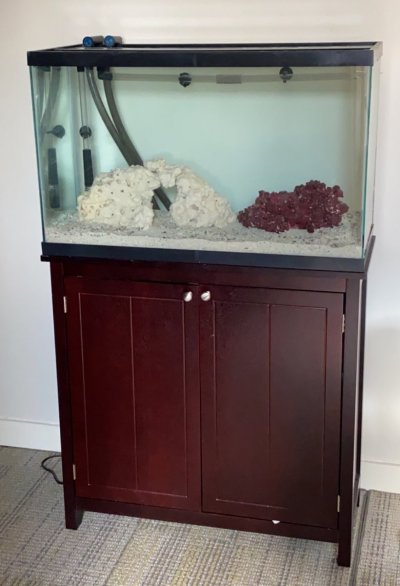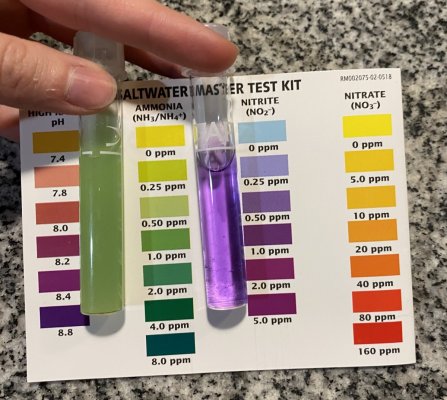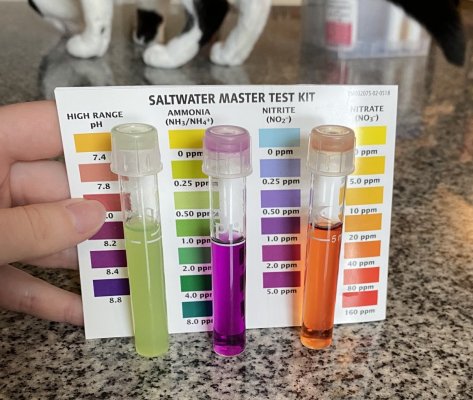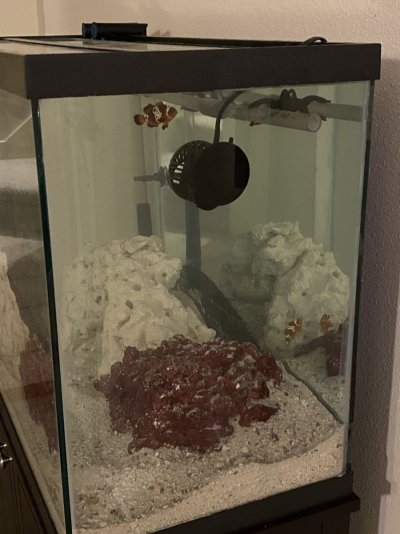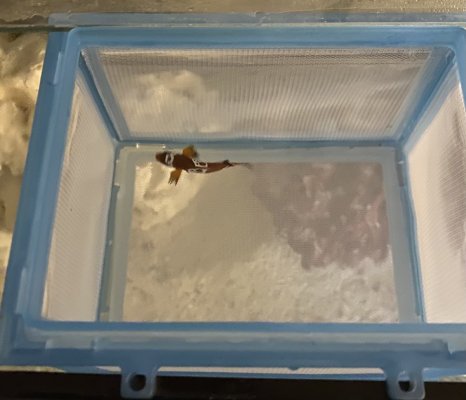Hello everyone!
This is going to be the build thread for the first ever saltwater tank that my partner and I have done. We have had success with freshwater in the past, but it is time for something new! In my introduction thread, @P-Dub referred to our nascent system as the Emerald Reef, which is a name I think we might stick with! I'm going to split this into sections.
Tank Setup
Our tank is a standard 30 gallon tank that we are switching from freshwater. It is all emptied out and ready to go. We have a canister filter, which is a bit unique, but we will see how it works! For a first tank, jumping into a sump right away just wasn't very feasible. In this picture, the tubes and hoses aren't set up yet, which is why the stand looks like a mess.
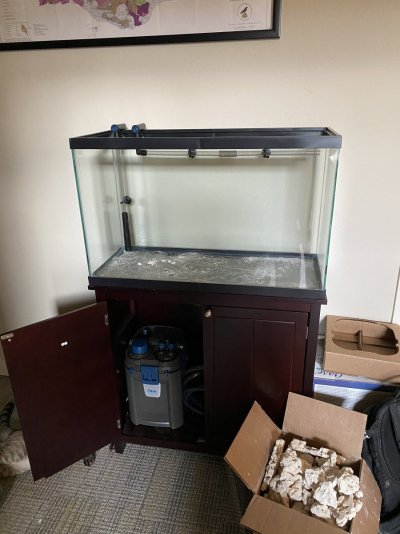
However! We are making some modifications to our canister. The model we have is the Oase BioMaster Thermo 250. It has a built in heater, fits underneath our small stand, and has a spray bar. The filter setup is a prefilter with four removable sponges, and in the main canister are four layers - three increasingly finer sponges, and a final layer of biomedia. We are switching this up a little bit, as I will explain in a minute.
The Rock Situation
So... Our original plan was buying 30lbs of dry rock rubble and constructing an extremely cool aquascape all by ourselves! Here is the rock we ordered:
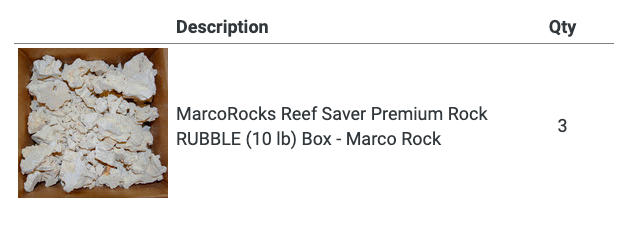
Which seemed perfect, since it would be a variety of sizes and we could make whatever shape we wanted. However....
The epoxy we got was not necessarily the easiest to work with - an aquarium safe putty. It was a huge pain, and what seemed to be a reasonable task soon became unreasonable. Here was a few angles of our "first draft" of an aquascape.
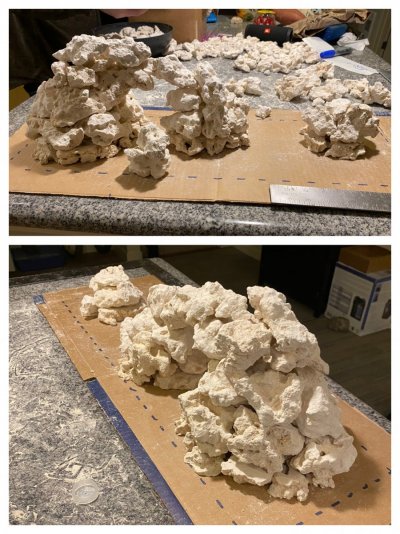
Unfortunately, I didn't get a picture of it set up in the tank, but it ended up being less than half the height of the tank, really blocky, and extremely hard to cement. So, we decided that a different approach might be better (I would definitely appreciate opinions here). It seemed like it would be hard for corals to grow on it, and could possibly be a dangerous rockfall hazard.
Well, now we have 30lbs of rock, most of which is just pebbles. What to do? Then, an idea struck - filter media! These little rocks will go to good use in the canister, and will be less of a pain than the sponges. The plan is to remove the three sponges from the main canister body and have three bags of this instead. This makes the canister a lot closer to a sump, right?
Later today we are going to get either the purple dry LifeRock or some actual live rocks. Our local saltwater aquarium specialty store has a great selection of rock for us to choose from.
Water!
Water has quickly become one of the biggest hurdles in our saltwater journey... and it hasn't even truly begun! The situation was looking pretty hopeless to begin with. We live in an apartment on the 5th floor with a roommate, so getting a big RODI system seemed pretty much impossible, but I really didn't want to use tap water and deal with all of the repercussions of that in a sensitive reef. What to do? Thankfully, @rkpetersen reached out and has been super helpful in this whole process, and he recommended buying our water to begin with. This seems like a perfect option! We get good water to start out our tank while not having to invest in the plumbing and headache of hooking up an RODI system. We have gotten some ideas for a faucet adapter to allow us to switch between RODI water and regular water, but this will be a future conundrum. I wonder if I'm going to end up posting pictures of my sinks on this crazy forum!
We purchased two 18 gallon bins and are going to buy 30 gallons of premixed saltwater and drive it back to our apartment complex. Even getting water from the store into the tubs in the bed of my truck is probably going to be a pain. From there I think we are planning on siphoning water into five gallon buckets and taking trips up the elevator until the bins are light enough to carry up themselves. We might ask the office if we can borrow a buggy - they have those carts that hotels use for luggage, and perhaps they will let us use it. Even then, I'm not sure how much weight they can carry. Saltwater is approx. 8.6ppg... multiple that by 18galx2 and you've got over 300lbs. Any way you turn it, getting the water up to the fifth floor is going to be one of the biggest nightmares of this whole operation.
For the future, we plan on keeping one of the totes full of saltwater for water changes. At a certain point I'm sure we'll get sick of buying water, but for now it makes more sense.
Cycling
Our plan for cycling is most likely using just regular fish food to add ammonia to begin. We currently have a bottle of Stability for bacteria. I know it's not as great as live bacteria, but depending on how it works we might get one of the nicer live ones. We have four leftover 5in1 testing strips that test pH, Nitrite, Nitrate, Carbonate and Hardness. Really we only need the nitrite, but it's something we don't need to buy, which is nice. Probably need to get an ammonia one eventually, but I keep hearing that we won't really use them, so maybe we can skip those if we wait long enough? We also have live sand to put into the tank when it's time, though our cat did puncture one of the bags and get bacteria soup all over the rug. Yuck.
Here are my leftover cycling questions: should we have our canister set up during the cycling process, and do we need to buy circulation pumps yet? If so, should they be running while cycling? This brings me to my next topic:
Future Gear
The local store seems hesitant to sell us things, strangely enough, so I'm still not 100% on what things we will need. Currently, we are planning to get a Radion XR15 G5 Blue for lighting when it is time for lights. I know we will need fans, so we will probably pick up some basic Marineland circulation pumps from the local pet store. Other than that, it sounds like we should wait and see what things crop up. I have heard that we'll need something that actually skims the surface of the tank, though I have gotten conflicting information there too. I don't think anyone agrees on anything in this hobby!
Future Livestock
I am pretty sure we are far from actually adding any creatures to the tank, but our thought in the short term is getting two pretty clownfish. We are hoping for a tank with just fish and softie corals for our first foray into the artificial sea. Our local store sells yellow tangs at every size, and recommended getting a very small one and said we will probably have a larger tank by the time it will need more space... Either that, or they do take fish back. I am worried our tank isn't big enough for a tang at any size. I would also like an emerald crab, since it is the Emerald Reef. We also think maybe shrimp or snails, but those would be much much later on.
In terms of corals, for sure we want green star polyps, xenia, and at least one mushroom. I got a list of beginner corals from BRS, and ones we saw at the store that we might be interested in are bubble corals and zoanthids. I think to start with we want the GSP and xenia and we'll see from there how things survive (hopefully!!)
Final Thoughts
Wow, this was a lot more than I thought I would write. In a couple days when we have the rock and water in the tank I'll post an update and some more pictures. All input would be appreciated, save telling us to get a sump... it just can't happen for our first little tank. Certainly for any future tank, but just not for right now.
Thank you so much for reading this huge post, and another thank you to @rkpetersen for all of his help during this process!
This is going to be the build thread for the first ever saltwater tank that my partner and I have done. We have had success with freshwater in the past, but it is time for something new! In my introduction thread, @P-Dub referred to our nascent system as the Emerald Reef, which is a name I think we might stick with! I'm going to split this into sections.
Tank Setup
Our tank is a standard 30 gallon tank that we are switching from freshwater. It is all emptied out and ready to go. We have a canister filter, which is a bit unique, but we will see how it works! For a first tank, jumping into a sump right away just wasn't very feasible. In this picture, the tubes and hoses aren't set up yet, which is why the stand looks like a mess.

However! We are making some modifications to our canister. The model we have is the Oase BioMaster Thermo 250. It has a built in heater, fits underneath our small stand, and has a spray bar. The filter setup is a prefilter with four removable sponges, and in the main canister are four layers - three increasingly finer sponges, and a final layer of biomedia. We are switching this up a little bit, as I will explain in a minute.
The Rock Situation
So... Our original plan was buying 30lbs of dry rock rubble and constructing an extremely cool aquascape all by ourselves! Here is the rock we ordered:

Which seemed perfect, since it would be a variety of sizes and we could make whatever shape we wanted. However....
The epoxy we got was not necessarily the easiest to work with - an aquarium safe putty. It was a huge pain, and what seemed to be a reasonable task soon became unreasonable. Here was a few angles of our "first draft" of an aquascape.

Unfortunately, I didn't get a picture of it set up in the tank, but it ended up being less than half the height of the tank, really blocky, and extremely hard to cement. So, we decided that a different approach might be better (I would definitely appreciate opinions here). It seemed like it would be hard for corals to grow on it, and could possibly be a dangerous rockfall hazard.
Well, now we have 30lbs of rock, most of which is just pebbles. What to do? Then, an idea struck - filter media! These little rocks will go to good use in the canister, and will be less of a pain than the sponges. The plan is to remove the three sponges from the main canister body and have three bags of this instead. This makes the canister a lot closer to a sump, right?
Later today we are going to get either the purple dry LifeRock or some actual live rocks. Our local saltwater aquarium specialty store has a great selection of rock for us to choose from.
Water!
Water has quickly become one of the biggest hurdles in our saltwater journey... and it hasn't even truly begun! The situation was looking pretty hopeless to begin with. We live in an apartment on the 5th floor with a roommate, so getting a big RODI system seemed pretty much impossible, but I really didn't want to use tap water and deal with all of the repercussions of that in a sensitive reef. What to do? Thankfully, @rkpetersen reached out and has been super helpful in this whole process, and he recommended buying our water to begin with. This seems like a perfect option! We get good water to start out our tank while not having to invest in the plumbing and headache of hooking up an RODI system. We have gotten some ideas for a faucet adapter to allow us to switch between RODI water and regular water, but this will be a future conundrum. I wonder if I'm going to end up posting pictures of my sinks on this crazy forum!
We purchased two 18 gallon bins and are going to buy 30 gallons of premixed saltwater and drive it back to our apartment complex. Even getting water from the store into the tubs in the bed of my truck is probably going to be a pain. From there I think we are planning on siphoning water into five gallon buckets and taking trips up the elevator until the bins are light enough to carry up themselves. We might ask the office if we can borrow a buggy - they have those carts that hotels use for luggage, and perhaps they will let us use it. Even then, I'm not sure how much weight they can carry. Saltwater is approx. 8.6ppg... multiple that by 18galx2 and you've got over 300lbs. Any way you turn it, getting the water up to the fifth floor is going to be one of the biggest nightmares of this whole operation.
For the future, we plan on keeping one of the totes full of saltwater for water changes. At a certain point I'm sure we'll get sick of buying water, but for now it makes more sense.
Cycling
Our plan for cycling is most likely using just regular fish food to add ammonia to begin. We currently have a bottle of Stability for bacteria. I know it's not as great as live bacteria, but depending on how it works we might get one of the nicer live ones. We have four leftover 5in1 testing strips that test pH, Nitrite, Nitrate, Carbonate and Hardness. Really we only need the nitrite, but it's something we don't need to buy, which is nice. Probably need to get an ammonia one eventually, but I keep hearing that we won't really use them, so maybe we can skip those if we wait long enough? We also have live sand to put into the tank when it's time, though our cat did puncture one of the bags and get bacteria soup all over the rug. Yuck.
Here are my leftover cycling questions: should we have our canister set up during the cycling process, and do we need to buy circulation pumps yet? If so, should they be running while cycling? This brings me to my next topic:
Future Gear
The local store seems hesitant to sell us things, strangely enough, so I'm still not 100% on what things we will need. Currently, we are planning to get a Radion XR15 G5 Blue for lighting when it is time for lights. I know we will need fans, so we will probably pick up some basic Marineland circulation pumps from the local pet store. Other than that, it sounds like we should wait and see what things crop up. I have heard that we'll need something that actually skims the surface of the tank, though I have gotten conflicting information there too. I don't think anyone agrees on anything in this hobby!
Future Livestock
I am pretty sure we are far from actually adding any creatures to the tank, but our thought in the short term is getting two pretty clownfish. We are hoping for a tank with just fish and softie corals for our first foray into the artificial sea. Our local store sells yellow tangs at every size, and recommended getting a very small one and said we will probably have a larger tank by the time it will need more space... Either that, or they do take fish back. I am worried our tank isn't big enough for a tang at any size. I would also like an emerald crab, since it is the Emerald Reef. We also think maybe shrimp or snails, but those would be much much later on.
In terms of corals, for sure we want green star polyps, xenia, and at least one mushroom. I got a list of beginner corals from BRS, and ones we saw at the store that we might be interested in are bubble corals and zoanthids. I think to start with we want the GSP and xenia and we'll see from there how things survive (hopefully!!)
Final Thoughts
Wow, this was a lot more than I thought I would write. In a couple days when we have the rock and water in the tank I'll post an update and some more pictures. All input would be appreciated, save telling us to get a sump... it just can't happen for our first little tank. Certainly for any future tank, but just not for right now.
Thank you so much for reading this huge post, and another thank you to @rkpetersen for all of his help during this process!
Last edited:








